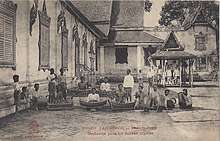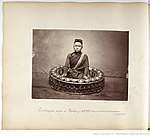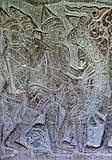Pinpeat
The Pinpeat (Khmer: ពិណពាទ្យ) is the largest Khmer traditional musical ensemble. It has performed the ceremonial music of the royal courts and temples of Cambodia since ancient times. The orchestra consists of approximately nine or ten instruments, mainly wind and percussion (including several varieties of xylophone and drums). It accompanies court dances, masked plays, shadow plays, and religious ceremonies.[1] This ensemble is originated in Cambodia since before Angkorian era.[2]

The pinpeat is analogous to the pinphat adopted from the Khmer court by the Lao people[3] and the piphat ensemble of Thailand.[4]
Etymology
According to Chuon Nath's Khmer dictionary, the 'Pinpeat' is composed of the Sanskrit terms vina/ pin (វិណ) referring to the pin (harp), which was formerly used as the premiere instrument in this ensemble, and vadya/ padya/ peat (វាទ្យ) referring to an ensemble of instruments.[5]
According to Sonankavei, the professor from the Department of Music of the Cambodian Royal University of Fine Art, the word pinpeat is derived from the combination of two musical instruments including pin (harp) and vadya/ peat, referring to a genre of kong called kongpeat.[6][7]
The Laotian adoption of Khmer pinpeat is called pinphat.[3] The term piphat was also used among Cambodians familiar with the Thai language; this can be attributed to the former annexation of the northern provinces of Cambodia,[5] however, Pinpeat in fact originated from Cambodia.[1]
History



The history of the pinpeat can be traced back to the origins Khmer music. The orchestra and its lead instrument of that era, the pin (harp), were introduced to early Khmer kingdoms from India, where the pin was depicted far back as the Gupta period (3rd century a.d. – 543 a.d.).[8] An example from that era can be seen in a relief at the Pawaya site in modern Madya Pradesh, India.[8] The pin may have been introduced to Cambodia in its first kingdom, Funan; however, few structures and evidence remain from this period.
The earliest surviving depiction of the pin in Cambodia is dated to the 7th century on the temple at Sambor Prey Kuk, part of another Khmer kingdom known in Chinese record as Chenla, the successor of Funan. This instrument appeared in Hindu religious art in temples from the 7th to 13th centuries A.D.[9][6] The instrument was frequently seen being depicted on the walls of Sambor Prey Kuk, Banteay Chhmar, Bayon, and other Khmer temples.[6][9] During the Angkor era (9th — 15th centuries a.d.), it was played in the royal Khmer ensemble and disappeared at the end of 12th century[9] Although the pin disappeared from pinpeat ensemble for some 800 years, the Khmer still called this kind of ensemble what it had been called since the ancient time.[6][10] In 2013, the pin was revived by Patrick Kersalé, a French ethnomusicologist and Sonankavei, a Cambodian musical craftsman and professor.[11][12] Modern musicians have begun experimenting, reincorporating the pin into the pinpeat, its place in the Angkorian court 800 years ago.
In 2014, more than 200 paintings were revealed at Angkor. The pinpeat ensemble was depicted in two hidden images discovered on the magnificent temple's wall. One of two images that depicted the pinpeat ensemble can be seen clearly through computer-enhancement and it is identical to today's pinpeat orchestra, including the absent pin.[13] Pipeat was also regarded as the royal ensemble and accompanied in Khmer traditional and royal festivities in the post-Angkorian periods until today.
The pinpeat, in its form originating in India, consisted of four musical instruments, the pin (harp), (Khloy) flute, (samphor) drum, and chhing (small cymbals), based on an Indian epic. The narration said that "One day, Shiva [who] resides in the gods assembly on the summit of Kailasa, intended to perform a dance. So he ordered Uma to reside on the golden throne, Sarasvati to play pin (vina), Indra to play the flute, Brahma to play chhing (cymbals), Laksmi to sing, and so that other devas and asuras would watch the performance..." Later on, more musical instruments were added or replaced by others and developed to form a unique Khmer musical ensemble.[14][15][10]
Today, the pinpeat incorporates kong gong chimes, such as the kong von thom, as lead instruments. This dates back as far as the Angkorian period, when there was a group of musicians called the kongpit/ kongpeat. Organized music in this period was centered around religious and royal organizations. On one side, two groups of musician served the Khmer brahmins and the buddhists, while on the other side, the pinpheat reflected the power of the Angkorian monarch.[2]
The pinpheat may have debuted in Southeast Asia during the first Khmer kingdom of Funan (1st-6th century AD). During that kingdom's existence, Indian religions, culture and traditions were introduced to Southeast Asia, beginning as early as the 1st century a.d. During the Funan period, there was a group of musicians called pinpang, and the pin was used as an instrument in the group. During the reign of Funan king Fan Chan (or Fan Siyon), 225-250 a.d., the country "entered relations" with the Murunda Dynasty, who ruled Kalinga in India.[16][17]
King Fan Chan is also known today for establishing relations with a ruler in Southern China during the Three Kingdoms period, sending as a present some musicians and products of the country to the "Kingdom of Kra Vo under the reign of the King Sun Chorn" (sometimes labeled "Chinese Emperor") in Southern China in 243 a.d.[16][18][19][20] Another record mentioned the Khmer musicians from Funan which visited China in 236 CE. The Chinese emperor was so impressed that he even ordered the institute of Funanese music near Naking.[21][20] Another Chinese source also mentioned the famous music of Funan (Cambodia) that became popular[22] and was played at the courts of Sui and Tang dynasties.[23] This “Funan music” was a ritual music and dance form with Buddhist coloring from the pre-Angkorian kingdom of Funan (Khmer, Nokor Phnom).[22]
Instruments used in Pinpeat ensembles
This list presents instruments which are or have been used in various Pinpeat ensembles.
- Roneat - xylophones
- roneat ek - the lead high-pitched bamboo xylophone.
- roneat thung - a xylophone, lower pitched than the roneat ek
- Roneat - metallophones
- roneat dek
- roneat thong
- Drums
- Sralai - a quadruple-reed
- sralai thom - a large quadruple-reed flute
- sralai toch - a small quadruple-reed flute
- Khloy - a type of bamboo flute (was used in place of the sralai in the past)
- Chhing (chhap) - finger cymbals
- Krap - wooden clappers (presently rarely used)
Type of Pinpeat Ensemble
Pipeat ensemble divided into different type depend on the instruments accompanied in its ensemble.
Pinpeat Vong Touch (Small Pinpeat Ensemble)
This small Pinpeat ensemble was thought to be the initial Pinpeat orchestra played since its origin until today, consisted of a few musical instruments[10] such as:
- Pin (obsolete)
- Roneat ek (1)
- Kong vong thum (1)
- Skor thum (2)
- Samphor (1)
- Sralai (1)
Pinpeat Vong Thum (Big Pinpeat Ensemble)
Since its introduction from India, the initial Pinpeat ensemble had been developed as more musical instruments were added or replaced by other local instruments. In the 3rd century, more instruments were added to the ensemble by Khmer craftsman and musicians. There we can see the emergence of various percussive instruments into the initial Pinpeat ensemble such as roneat thung, roneat dek, kong vong touch, sralai touch,..[10]
The insert of these local instruments into the initial Pinpeat ensemble (small pinpeat ensemble) make the music made by the ensemble more flawless, gentle, and melodious than it previously do. This ensemble is called Pinpeat Vong Thum (Big Pinpeat Ensemble) with more instruments:[10]
- Pin (obsolete)
- Roneat ek (1)
- Roneat thung (1)
- Roneat dek (1)
- Kong vong thum (1)
- Kong vong touch (1)
- Sralai (1)
- Skor thum (2)
- Samphor (1)
- Chhing (1 pair)
List of Pinpeat songs
Today, there are more than 250 Pinpeat songs being researched based on a document found in the street of Phnom Penh in 1979 after Khmer Rouge collapsed. These songs narrated various stories such as describing love, nature, Khmer daily life and its neighbors, and else. While some specific musics are used to accompany in Khmer traditional dances and theaters.
Pinpeat musics used for Khol Masked Drama and Sbek Thom (Khmer Shadow theatre)
Sathukar is the principle Cambodian Pinpeat music plays for the opening of Khmer traditional festivities and rituals. Sathukar accompanies in Cambodian Royal Ballets, Masked Drama, Shadow Theatre, and many other traditional dances and rituals. The music list below is played in accordance to various episodes in Masked Drama and Shadow theatre.[24]
- Sathukar: accompanied in for the opening rituals of the drama and paying homage to ancestral guru.
- Bot Ror: played for the magical and power expression episodes
- Bot Chert: played for traveling and warring episode
- Bot S'mer: played during the paying respect and taking a rest episode
- Bot Trak: making magics, transforming physical appearance or while shooting an arrow episode
- Bot Domner Knung: played during the marching of giant troops episode
- Bot Domner Krav: played for the human and monkey marching episode
- Bakthorm: for monkey troops marching episode
- Bonh Lea: used for the ending or departure (good bye) episode
- Bot Ot Toch: played during the hardship, crying (for human, giant, and monkey) episode
- Bot Ot Thum: played during the hardship, break up, crying down (for human and monkey characters)
- Bot Tayoy: played during sentiment anxiety ( for human characters)
- Bot Chert Chhoerng: played during arrow shooting or undermine the ritual episode
- Bot Neang Lot: played for comedian character or the traveling of the locals
- Bot Chert Chhab: played for monkeys wrestling episode
- Bot Khlom: played during the march of devatas, Indra episode
- Bot Pon Nhea: accompanied during the return of Preah Ream/ Rama's troops episode
Pinpeat Song narrating Khmer daily activities
- Khmer Preah Bantum
- Khmer Tumnerb (Modern Khmer)
- Khmer Chrot Srov (Khmer harvests rice)
- Khmer Dambaanh (Khmer weaves (textile)
- Khmer Bompe Kon (Khmer lulls the child)
- Khmer Yol Tong (Khmer swings the swing)
- Kamrong Phuong Khmer (Khmer flower braid)
- Khmer Plum Sloek (Khmer blows the leaf)
- Domner Khmer (Khmer walking)
- Khmer Pursat
- Khmer Kruosar (Family Khmer)
Pinpeat Songs related with Khmer neighbors; Chen (Chinese), Chvea (Javanese), Leav (Laotian), Mon, Pumea (Bamar), and Kuy.
- Chen Louk Thnam (Chen Sae)
- Chen Bong (Chen Chombong)
- Chen Chas
- Chen Chong Srok
- Chen Tver Chhnang
- Chen Berk Viangnon
- Chen Jos Touk
- Chen Tror Kaew
- Chen Chhor Muk Tuok
- Chen Bang Tang Yu
- Chen Bes Sloek Chher
- Domner Chen
- Chvea Srok Mon Pi Nakk
- Chvea Srok Mon Bei Nakk
- Chvea Srok Mon Bei Joan
- Chvea Tromiak Domrei
- Chvea Pho Kda
- Chvea Roam Phlet
- Chvea P'nek Khla
- Chvea Lerng Rong
- Chvea Srav Yuth'ka
- Chvea Der Tes
- Chvea Der Phum
- Chvea Reach Borei
- Chvea Nop Borei
- Chvea Srok Chav Sen
- Chvea K'soek K'soul
- Rabam Chvea
- Phleng Chvea
- Mon Jos Tuok
- Mon Yol Dav
- Roam Mon
- Phleng Mon
- Mon Samai
- Leav Piek Kra'op
- Leav P'song Tien
- Tomnounh Leav
- Samdech Leav
- Leav Ruom Chet
- Srei Leav Laor
- Chiet Leav
- Somrerb Chet Leav
- Kon Chiet Leav
- Teahean Chiet Leav
- Nisai Leav
- Robam Leav
- Leav Antrong Moan
- Leav Lerng Chrang
- Leav Tiak Rolok
- Leav Der Prei
- Leav Sorser Preah Chan
- Phumea Hor
- Kuy Kong Leng
Pinpeat Songs describe others
- Roam Phlet
- Domner Yeut
- Domner Rohas
- Bes Bopha
- Smarodei Ton
- Pekhachon
- Tep Pra Rorp
- Tep Rum Choul
- Tevada P'tum
- Tevada Nimitr
- Srei Snom Bomrer
- Soeng Thum Jorjoan
- Sorser Pkay
- Pkay Meas
- Raksmei Pkay
- Pkay Andet
- Raksmei Chouk Chei
- Ngiev Ph'laeng
- Ponleu Pech
- Many others.
Significance
All kind of Pinpeat ensembles play significant role in Cambodian society and daily life since its origin.
The small Pinpeat ensemble is accompanied in various Cambodian national festivals, Buddhist celebrations, traditional dances, traditional drama, funeral, and other rituals.[10]
While the big Pinpeat ensemble play more role and significance than the previous. These roles include:
- Accompanied in the congratulation for the troop march returned to the city defeated the enemies.
- Accompanied in the yoyal festivities such as Royal Boats Racing, Royal Plowing,.....etc
- Accompanied in Buddhist celebrations and rituals such as Pchhum Ben, Kathin, Bon Pkar, Bonchos Seima, funerals,..etc
- Accompanied in traditional dances Robam Jumpor (blessing dance), Robam Tep Monorum, Robam Apsara, Robam Sovan Maccha,..etc and traditional dramas and shows such as Khol, Sbek Thum and Sbek Touch (shadow plays), Puppet Show, Reamker Drama,...etc. Sometimes this ensemble can be performed in other local rituals as well.
See also
References
Notes
- "Sounds of Angkor". smileofangkor.info. Retrieved 2019-08-08.
- "ប្រវត្តិភ្លេងបុរាណខ្មែរ "ពិណពាទ្យ" ដែលខ្មែរយើងយល់ច្រឡំថាជារបស់ថៃ". ទុកផ្លូវក្រោយ (in Khmer). Retrieved 2019-08-08.
- "The musicians | Phralak Phralam". phralakphralam.com. Retrieved 2019-08-08.
- Sam-Ang Sam "Cambodia" in New Grove Dictionary of Music and Musicians, 2nd ed., 2001. pp. 861-863
- Chuon Nath Khmer Dictionary. 1966, Buddhist Institute, Phnom Penh
- DEV, CAMWP (2016-03-20). "ប្រវត្តិពិណខ្មែរ". WMC. Retrieved 2019-08-08.
- Royal Ballet July 2008 (PDF). Cambodia: Cambodia Ministry of Culture and Fine Arts With the contribution of UNESCO/Japanese Funds-in-Trust. 2008. p. 53.
Khmer people call this music “Pin Peat” because this orchestra combines Pin and Peat (Koang Peat) instruments
- Kersalé, Patrick. "Pre-Angkorian Harp". soundsofangkor.org. Retrieved 21 August 2019.
- Powell, Alexandra (July 2013). "Independence Monument, Phnom Penh, Cambodia". Spine. 38 (15): i. doi:10.1097/brs.0b013e31829ddec6. ISSN 0362-2436.
- Kong, Kannika. "ភ្លេងពិណពាទ្យ – ភ្លេងសៀម? | eLibrary of Cambodia". Retrieved 2019-08-09.
- "Cambodia works to revive an ancient harp, plucked from a temple wall". Public Radio International. Retrieved 2019-08-08.
- "Angkorian harp reborn | Phnom Penh Post". www.phnompenhpost.com. Retrieved 2019-08-08.
- Masis, Julie. "Popular Archeology - The Hidden Art of Angkor Wat". Popular Archeology. Retrieved 2019-08-08.
- Kersalé, Patrick. "THE ANCIENT MUSICAL INSTRUMENTS THROUGH SHIVA'S DANCES". soundsofangkor.org. Retrieved 21 August 2019.
[In the section 'The instruments of the Shiva’s dances from a Khmer legend', musicologist Patrick Kersalé reported that a version of this legend had been collected in Cambodia in the 1960s by Jacques Brunet.]
- "Pheng Visotharamuny: ប្រវត្ដិក្រុមភ្លេងពិណពាទ្យ". Pheng Visotharamuny. 2014-08-24. Retrieved 2019-08-09.
- Coedès, George (1968). Vella, Walter F (ed.). Les états hindouisés d'Indochine et d'Indonésie [The Indianized States of South-East Asia]. Honolulu: University of Hawaii Press. pp. 40–42. ISBN 0-8248-0368-X.
between 225 and 250...first to enter into official and direct relations with the princes of India...according to the History of the Three Kingdoms, who in 243 'sent an embassy [to China] to offer a present of musicians and products to the country'
- Kalia, Ravi (1994). Bhubaneswar: From a Temple Town to a Capital City. Carbondale and Edwardsville, Illinois: Southern Illinois University Press. p. 17. ISBN 9780809318766.
Bhuddism reasserted itself in Kalinga under the Murunda dynasty in the third century A.D.
- Royal Ballet July 2008 (PDF). Cambodia: Cambodia Ministry of Culture and Fine Arts With the contribution of UNESCO/Japanese Funds-in-Trust. 2008. p. v53.
(A.D. 240 – 243), the King Fan Siyon had Khmer dance and orchestra. He sent his performing team to the Kingdom of Kra Vo under the reign of the King Sun Chorn in Southern China. The orchestra was Pin Peat...
- Sagar, Krishna Chandra (2002). An Era of Peace. Northern Book Center. p. 60. ISBN 9788172111212.
- "The Dawn of Ancient Khmer-Chinese Relations". Peace Post Asia. Retrieved 2019-08-08.
- D.R.Sardesai, Southeast Asia: Past And Present, 3rd ed. 1994, Westview Press, ISBN 978-0-8133-1706-9, p.23
- "China's Cultural Exchange with Southeast Asia". en.chiculture.net. Retrieved 2019-08-08.
- Theobald, Ulrich. "Funan 扶南 (www.chinaknowledge.de)". www.chinaknowledge.de. Retrieved 2019-08-08.
- Pech Tum Kravel. Khmer Masked Theatre. 163. Retrieved from https://drive.google.com/file/d/0B7OmNithn8yCc0Zpa1cxaVlmSHM/view